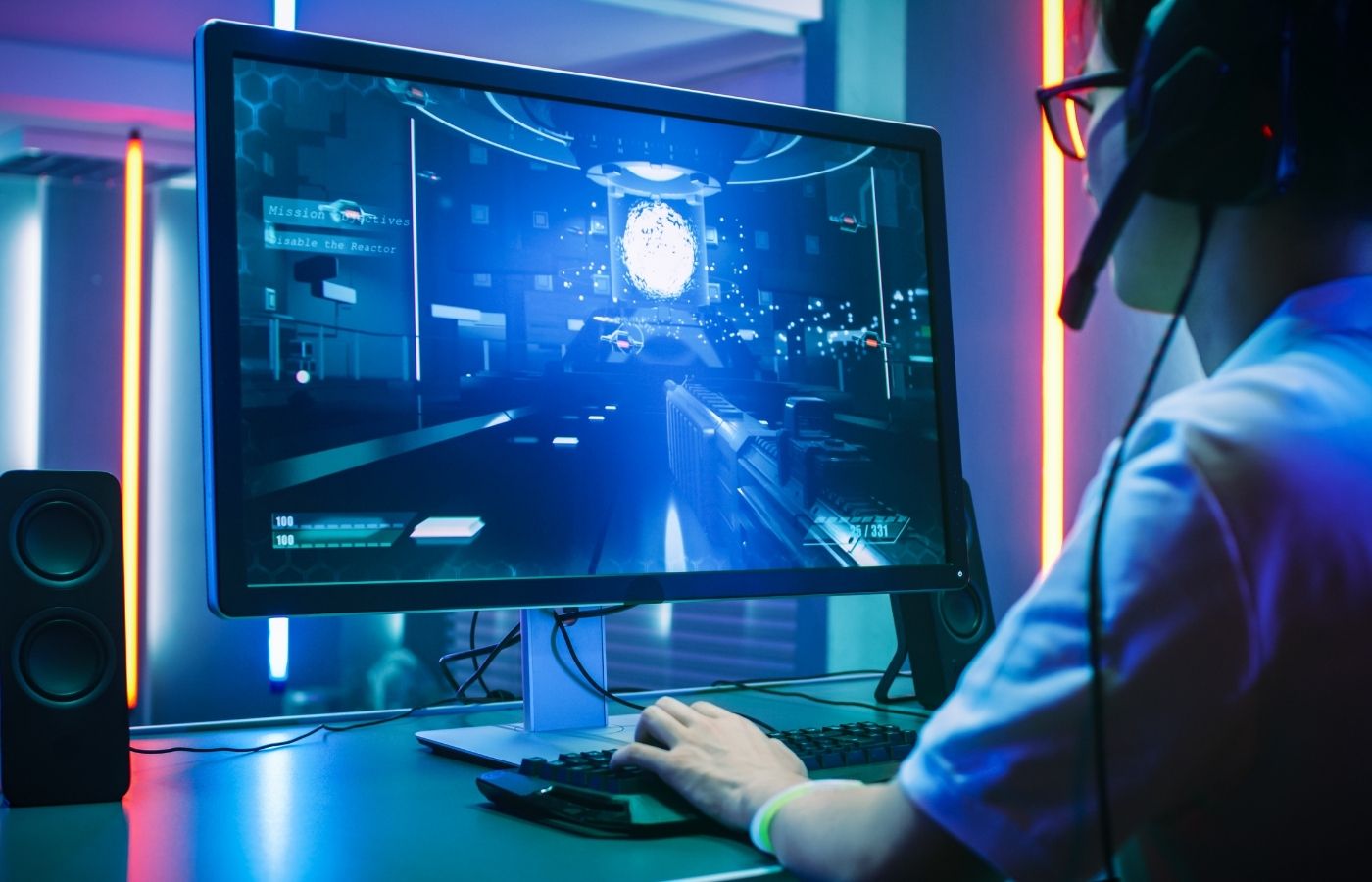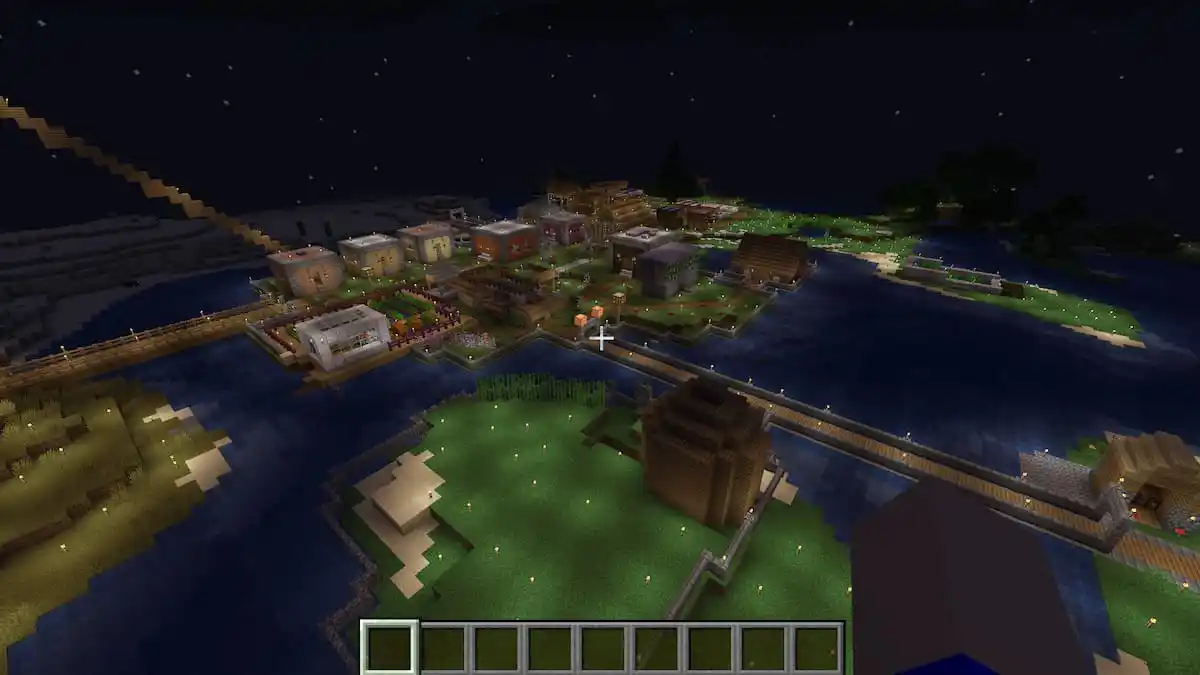Introduction
Welcome to the exciting world of online gaming! If you’re someone who enjoys playing multiplayer games, you may have thought about hosting your own gaming server. Hosting your own server allows you to have greater control over the game environment, customize settings, and invite friends or other players to join you for a truly unique gaming experience.
In this article, we will guide you through the process of hosting an online gaming server. Whether you’re a seasoned gamer or new to the world of servers, this step-by-step guide will provide you with all the information you need to get started. From choosing the right game server software to ensuring server security and optimizing performance, we’ve got you covered.
Before we dive into the technical details, it’s important to note that hosting an online gaming server requires some technical knowledge and understanding of computer networks. However, don’t worry if you’re not an expert. We’ll break down the process into simple, easy-to-understand steps to help you navigate through the setup process.
Hosting an online gaming server offers several advantages. Firstly, it gives you control over the game environment, allowing you to customize gameplay settings according to your preferences. You can set up game modes, adjust difficulty levels, and even incorporate mods or additional content into the game.
Secondly, hosting your own server enables you to invite friends or other players to join you in the game. Whether you want to have a private gaming session with your friends or create a community for likeminded players, a dedicated server provides a reliable and secure platform for multiplayer gaming.
Another benefit of hosting your own server is the ability to effectively manage player access and admin permissions. This means you have the power to control who can join the server, ban unruly players, and enforce rules to maintain a healthy gaming environment.
Lastly, hosting your own server gives you the flexibility to optimize its performance. You can fine-tune server settings, allocate resources appropriately, and implement security measures to ensure a smooth and uninterrupted gaming experience for all players.
Now that you understand the advantages of hosting your own gaming server, let’s jump right into the steps involved in setting it up. By the end of this guide, you’ll have all the knowledge and tools necessary to embark on your server hosting journey and create a thriving gaming community.
Step 1: Choosing the Right Game Server Software
The first step on your journey to hosting an online gaming server is selecting the right game server software. Game server software acts as the foundation of your server, managing game mechanics, player interactions, and other crucial components of the gaming experience. With a wide range of options available, it’s important to choose software that is compatible with your desired game and offers the features you need.
When choosing game server software, consider the following factors:
- Compatibility: Ensure that the software you choose is compatible with the game you want to host. Different games may have specific server software designed for them, so be sure to check the requirements for the game you plan to host.
- Features and Customization: Assess the features offered by the server software. Look for options that allow you to customize gameplay settings, manage player access and permissions, and easily update the server software when necessary. The more flexibility and control you have, the better.
- Community and Support: Investigate the community surrounding the server software. Is there an active user base? Are there forums or resources available for troubleshooting and support? Having access to a supportive community can be immensely valuable when setting up and maintaining your server.
- Performance and Stability: Consider the performance and stability of the server software. Look for software that is known for providing a reliable and lag-free gaming experience. Read reviews or seek recommendations from other server administrators to assess the software’s performance track record.
- Scalability: If you have plans to expand your server in the future and accommodate more players, choose software that allows for scalability. This means the software should be able to handle increased player loads and resources without sacrificing performance.
Popular game server software options include Minecraft Server, Counter-Strike: Global Offensive (CS:GO) Server, ARK: Survival Evolved Dedicated Server, and Rust Server, just to name a few. Research and explore the features of different software options to find the one that best suits your needs.
Once you’ve chosen the game server software that aligns with your requirements, it’s time to move on to the next step: selecting the hosting platform. We’ll discuss this in detail in the next section.
Step 2: Selecting the Hosting Platform
After choosing the game server software, the next step in hosting your online gaming server is selecting the right hosting platform. The hosting platform you choose will determine the performance, reliability, and accessibility of your server. It’s essential to consider various factors when making this decision.
Here are some key considerations when selecting a hosting platform:
- Server Requirements: Review the system requirements of your chosen game server software. Make sure the hosting platform meets or exceeds those requirements in terms of hardware, operating system compatibility, and network capabilities.
- Scalability: Consider the future growth of your server. If you anticipate a larger player base or increased resource requirements, opt for a hosting platform that allows for easy scalability. This will enable you to seamlessly upgrade your server resources as needed.
- Uptime and Reliability: Look for a hosting platform that offers a high level of uptime and reliability. Downtime can disrupt the gaming experience for your players, so prioritize a hosting provider with a proven track record of stability.
- Network Connectivity: A stable and high-speed internet connection is crucial for an optimal gaming experience. Ensure that the hosting platform provides robust network connectivity to minimize lag and latency for players connecting to your server from different locations.
- Customer Support: Hosting platforms with responsive and knowledgeable customer support can be invaluable when technical issues arise. Check for reviews or testimonials regarding customer support to ensure that help will be readily available whenever you need it.
- Cost: Evaluate the pricing plans offered by different hosting platforms. Consider your budget and compare the features and resources included in each plan to find the best value for your needs.
There are various hosting options available, each with its own advantages and trade-offs. Here are some common hosting platforms used for online gaming servers:
- Dedicated Server: Hosting your server on a dedicated machine provides the highest level of control, performance, and flexibility. You have full access to the server’s resources and can customize it to suit your needs. However, dedicated servers can be more expensive and require more technical expertise to set up and manage.
- Virtual Private Server (VPS): A VPS offers a balance between cost and control. With a VPS, you’re allocated a portion of a physical server, giving you more control over server settings and resources compared to a shared hosting environment. VPS hosting is often more affordable than a dedicated server.
- Game Server Hosting Providers: There are specialized hosting providers that cater specifically to gaming servers. These providers offer preconfigured server setups, making it easy to get started without worrying about server management. While this option may have some limitations in terms of customization, it is a convenient choice for beginners or those who prefer a managed hosting environment.
Consider your specific needs, budget, and level of technical expertise when choosing a hosting platform. Once you’ve made your decision, it’s time to move on to the next step: setting up the server environment.
Step 3: Setting up the Server Environment
Now that you have chosen the game server software and a hosting platform, it’s time to set up the server environment. This step involves configuring the necessary components to ensure a smooth and reliable gaming experience.
Here are the key steps to setting up the server environment:
- Installing the Game Server Software: Follow the instructions provided by the game server software to install it on your chosen hosting platform. This may involve downloading files, running installation scripts, or utilizing a control panel provided by the hosting platform.
- Configuring Firewall and Ports: Ensure that the necessary ports are open on your server’s firewall to allow incoming and outgoing traffic for the game server. Consult the documentation of both the game server software and the hosting platform for instructions on configuring firewalls and ports.
- Managing Server Files: Familiarize yourself with the server files and directories. You may need to upload additional game assets, mods, or plugins to customize the gaming experience. Understanding the structure of the server files will make it easier to manage and customize your server.
- Creating Server Scripts: Depending on the game server software and your specific requirements, you may need to create server scripts or configuration files. These scripts allow you to set up features such as scheduled server restarts, automated backups, or custom gameplay settings. Refer to the software documentation for guidance on creating and implementing these scripts.
- Installing Server Plugins or Mods: If you intend to enhance your server with plugins or mods, follow the instructions provided by the game server software and the specific plugins or mods you wish to install. This may involve downloading files, configuring settings, and ensuring compatibility with your game server software.
- Testing and Troubleshooting: Before opening your server to players, thoroughly test its functionality. Join the server, playtest various game modes, and verify that all desired features are working as intended. Additionally, be prepared to troubleshoot any issues that may arise during the testing phase. Consult the documentation or reach out to the community for assistance if needed.
Take your time to configure the server environment correctly and ensure that everything is functioning properly. Remember to regularly update the game server software and any installed plugins or mods to benefit from bug fixes, performance improvements, and new features.
Now that you have successfully set up the server environment, it’s time to move on to the next step: configuring server settings. This will allow you to customize the gameplay experience and manage player interactions on your gaming server.
Step 4: Configuring Server Settings
Once you have set up the server environment, the next step in hosting an online gaming server is configuring the server settings. These settings determine various aspects of the gameplay experience, including game modes, player limits, difficulty levels, and more. Configuring the server settings allows you to customize the game to suit your preferences and create a unique gaming experience for your players.
Here are the key steps to configuring server settings:
- Game Modes and Maps: Determine the game modes and maps available on your server. Most game server software provides configuration files where you can define different game modes and specify the rotation of maps. Make sure to refer to the software documentation for instructions on configuring game modes and maps.
- Player Limits: Decide on the maximum number of players allowed on your server. Set player limits based on server resources, game mode preferences, and the overall experience you want to create. Consider the performance of your hosting platform and the game server software to ensure smooth gameplay even with the maximum number of players.
- Difficulty and Gameplay Settings: Adjust difficulty levels and customize gameplay settings according to your preferences. This may include factors such as spawn rates, resource availability, time limits, damage values, and more. Experiment with different settings to find the right balance that suits your players.
- Rules and Guidelines: Establish server rules and guidelines to maintain a positive gaming environment. Clearly communicate these rules to players, either through a server message or a dedicated website. Enforce rules consistently to ensure fair play and discourage disruptive behavior.
- Admin Controls: Determine the admin controls and permissions available on your server. Assign trusted individuals as administrators to help manage the server, enforce rules, and oversee player interactions. Set up different permission levels based on the responsibilities and trustworthiness of the administrators.
- Regular Backups: Set up a backup system to regularly save server data. Backups are crucial in case of server crashes, data corruption, or other unforeseen events. Consult the game server software documentation or hosting platform resources to learn how to schedule automatic backups or perform manual backups.
Keep in mind that server settings can greatly impact the gameplay experience. It’s a good practice to gather feedback from players and make adjustments as necessary. The ability to fine-tune settings and create a unique server environment is one of the main benefits of hosting your own gaming server.
With the server settings configured, you’re ready to move on to the next step: managing player access and admin permissions. This step will allow you to control who can join your server and administer it effectively.
Step 5: Managing Player Access and Admin Permissions
A crucial aspect of hosting an online gaming server is managing player access and admin permissions. This step ensures that only authorized players can join the server while granting administrators the necessary capabilities to oversee and moderate the gaming environment.
Here are the key steps to managing player access and admin permissions:
- Whitelisting and Blacklisting: Utilize a whitelist or blacklist system to control who can join your server. Whitelisting allows only specified players to join, while blacklisting blocks specific players or IP addresses from accessing the server. Configure these lists based on your desired level of exclusivity or to prevent unwanted players from joining.
- Player Registration: Require players to register before joining the server. This process can involve providing a username and password or integrating external authentication systems, such as Steam, to verify player identities. Player registration helps maintain a sense of accountability and discourages disruptive behavior.
- Admin Permissions and Commands: Define the permissions and commands available to administrators. Assign different levels of access and powers to ensure that each administrator has the necessary tools to fulfill their responsibilities. Common admin commands include kicking or banning players, managing server settings, and monitoring server performance.
- Reporting and Monitoring: Implement systems for players to report any rule violations or issues they encounter. Consider integrating plugins or tools that allow players to submit reports or contact administrators directly. Regularly monitor server logs and player interactions to spot any misconduct and take appropriate action.
- Community Guidelines: Establish clear community guidelines that outline expected behavior and consequences for rule violations. Communicate these guidelines to all players through a server message, website, or dedicated forum. Regularly reinforce these guidelines to promote a respectful and enjoyable gaming environment.
- Regular Player Engagement: Engage with your player community regularly. Encourage players to provide feedback, suggestions, and report any issues they encounter. Listen to player concerns and implement changes or address issues promptly. Regular engagement fosters a sense of community and encourages players to actively participate and contribute positively to the server.
It’s important to strike a balance between maintaining a welcoming gaming environment and enforcing rules. Consistently apply your player access and admin permissions systems to ensure fairness and accountability.
Now that you have successfully managed player access and admin permissions, it’s time to focus on server security and DDoS protection. Protecting your server from malicious attacks is crucial to maintain its stability and ensure a secure gaming experience for your players.
Step 6: Ensuring Server Security and DDoS Protection
Ensuring server security and protection against DDoS (Distributed Denial of Service) attacks is essential to maintain the stability and integrity of your online gaming server. By implementing robust security measures, you can protect your server and provide a safe gaming environment for your players.
Here are the key steps to ensuring server security and DDoS protection:
- Secure Server Configuration: Configure your server with security in mind. Follow best practices, such as disabling unnecessary services, limiting remote access, using strong passwords, and regularly updating your server’s software and operating system.
- Firewall and Network Security: Implement a robust firewall and network security measures to protect against unauthorized access. Configure your server’s firewall to block malicious traffic and allow only legitimate connections. Consider using intrusion detection systems (IDS) or intrusion prevention systems (IPS) to proactively monitor and block potential threats.
- DDoS Protection: DDoS attacks can disrupt the availability of your server by overwhelming it with a flood of traffic. Consider using a DDoS protection service or implementing DDoS mitigation techniques to thwart these attacks. This may involve using a Content Delivery Network (CDN) with DDoS protection capabilities, utilizing rate limiting and traffic profiling, or collaborating with your hosting provider to implement mitigation measures.
- Regular Backups: Back up your server data regularly to safeguard against data loss or server compromise. Store backups in secure, off-site locations or utilize cloud-based backup services. Regular backups allow you to restore your server to a previous state in case of a security incident or other unforeseen events.
- Monitoring and Logging: Set up comprehensive monitoring and logging systems to track server activities, detect potential security breaches, and investigate any suspicious behavior. Utilize security information and event management (SIEM) tools or log analysis solutions to analyze logs for signs of intrusion or suspicious activities.
- Regular Security Audits: Conduct regular security audits to identify vulnerabilities and weaknesses in your server’s configuration. This may involve performing penetration testing, vulnerability scanning, or code reviews to assess the server’s security posture and address any identified issues.
- Stay Informed: Stay updated on the latest security threats, vulnerabilities, and mitigation techniques in the gaming server community. Join relevant forums or communities to learn from other server administrators and security experts. Regularly patch and update your server’s software to address any newly discovered vulnerabilities.
Implementing robust server security measures and having a proactive approach to DDoS protection can significantly enhance the security and resilience of your gaming server. By safeguarding your server, you pave the way for a safe and enjoyable gaming experience for your players.
Now that you have taken steps to ensure server security and DDoS protection, it’s time to focus on optimizing server performance to provide the best gaming experience possible. In the next step, we will explore techniques to tune and enhance your server’s performance.
Step 7: Optimizing Server Performance
Optimizing server performance is crucial to provide a smooth and enjoyable gaming experience for your players. By implementing performance optimization techniques, you can ensure that your online gaming server runs efficiently and minimizes lag or latency issues.
Here are the key steps to optimizing server performance:
- Server Resource Allocation: Allocate server resources, such as CPU, RAM, and disk space, appropriately to ensure balanced performance. Depending on your hosting platform, you may have access to server management tools that allow you to adjust resource allocation based on current server usage and player demands.
- Network Optimization: Optimize your network settings to reduce latency and improve the responsiveness of your server. Consider implementing techniques such as Quality of Service (QoS) to prioritize gaming traffic, enabling traffic shaping to control bandwidth usage, and utilizing network optimization tools to reduce packet loss.
- Server Tick Rate: Adjust the server’s tick rate to optimize network updates and gameplay responsiveness. The tick rate determines the frequency at which the server sends updates to connected players. A higher tick rate typically provides a smoother gameplay experience, but it can also increase server resource usage. Find the right balance based on the capabilities of your server and the demands of the game.
- Server Plugins and Mods: Evaluate the plugins and mods installed on your game server. While they can enhance gameplay, they may also impact server performance. Remove or replace any plugins or mods that significantly affect server performance or cause conflicts.
- Optimized Server Settings: Fine-tune the game server settings to optimize performance. Experiment with different settings related to resource utilization, player interactions, and game mechanics to find the optimal balance. Adjust values such as view distance, entity counts, and server tick rates to improve performance while maintaining a satisfying gameplay experience.
- Regular Maintenance: Perform regular maintenance tasks, such as cleaning up server files, removing unused mods or plugins, and updating game server software. Regular maintenance helps to keep your server running smoothly and efficiently.
- Server Monitoring: Utilize server monitoring tools to keep track of server performance metrics, such as CPU and memory usage, network traffic, and player activity. Monitoring allows you to identify potential performance bottlenecks and take proactive measures to resolve them.
- Server Optimization Guides: Consult optimization guides, forums, and resources specific to your game server software. Gaming communities often share insights and best practices to optimize server performance for popular games. These resources can provide valuable tips and techniques to improve your server’s performance.
By consistently implementing performance optimization techniques and staying proactive in monitoring and maintaining your server, you can provide an optimal gaming experience that keeps players coming back for more.
Now that you have optimized your server’s performance, it’s time to address any potential issues or challenges that may arise. In the next step, we will explore common server issues and how to troubleshoot them effectively.
Step 8: Troubleshooting Common Server Issues
As a server administrator, you may encounter various issues or challenges while hosting an online gaming server. Understanding how to troubleshoot common server issues is vital to ensure the smooth operation of your server and provide a seamless gaming experience for your players.
Here are some common server issues and troubleshooting steps:
- Connectivity Problems: If players are having trouble connecting to your server, check the server’s network settings, firewall configurations, and port forwarding rules. Ensure that necessary ports are open and correctly mapped to your server’s IP address.
- Performance Bottlenecks: If your server experiences lag or performance issues, investigate possible causes such as high CPU or memory usage, network congestion, or excessive server load. Use monitoring tools to identify bottlenecks and adjust server settings or allocate additional resources if necessary.
- Mod or Plugin Compatibility: If you’ve installed mods or plugins and encounter compatibility issues or crashes, verify their compatibility with your game server software version. Update or replace incompatible mods or plugins to prevent conflicts.
- Server Crashes: Server crashes can occur due to various reasons, such as software bugs, hardware issues, or excessive resource usage. Check server logs for error messages or crash reports. Update the game server software to the latest stable version, and if crashes persist, consider contacting technical support or seeking assistance from the game’s community forums.
- Database Corruption or Data Loss: If your server’s database becomes corrupted or experiences data loss, try to restore from a recent backup. Regularly back up your server data to minimize the impact of such issues. If backups are not available, consult database recovery resources or consider seeking professional assistance.
- Security Breaches: If you suspect unauthorized access or a security breach, immediately take action to safeguard your server and players’ data. Change passwords, patch vulnerabilities, and implement additional security measures. Investigate the incident and consider informing affected players about the breach, especially if personal data may have been compromised.
- Player Disputes or Misconduct: Address player disputes or misconduct swiftly and in accordance with your server’s rules and guidelines. Listen to both parties involved, gather evidence if necessary, and apply appropriate actions, such as warnings, temporary bans, or permanent bans. Be fair and consistent in enforcing disciplinary measures.
- Server Updates and Compatibility: Regularly update your game server software and installed mods or plugins to benefit from bug fixes, performance improvements, and new features. Prioritize compatibility between the server software, mods, and plugins to avoid compatibility issues.
Remember to maintain good communication with your players and encourage them to report any issues or concerns they encounter. Actively engage with the community and seek solutions together. The ability to troubleshoot common server issues is essential in providing a stable and enjoyable gaming experience.
With the knowledge and skills gained from troubleshooting common server issues, you can confidently manage and maintain your online gaming server. Remember to stay informed about new updates, security measures, and community resources to continually improve your server hosting abilities.
Conclusion
Hosting an online gaming server is an exciting venture that allows you to create a unique gaming experience for yourself and others. By following the step-by-step guide outlined in this article, you now have the knowledge and tools to successfully set up and manage your own gaming server.
From choosing the right game server software to configuring server settings, managing player access, ensuring security and DDoS protection, optimizing performance, and troubleshooting common issues, you have learned the key aspects of hosting an online gaming server. This journey requires technical knowledge, dedication, and a commitment to providing a positive gaming environment for your players.
Remember, the server environment is continuously evolving, and staying up to date with the latest trends, updates, and community resources is crucial. Engage with your player community, seek feedback, and adjust server settings and features based on player preferences. Regular maintenance, updates, and monitoring will help ensure the smooth operation of your server.
Lastly, be patient and enjoy the process. Hosting your own gaming server allows you to bring people together, create new friendships, and foster a sense of community. Embrace the challenges and rewards that come with being a server administrator, and have fun crafting an extraordinary gaming experience for yourself and others.

























